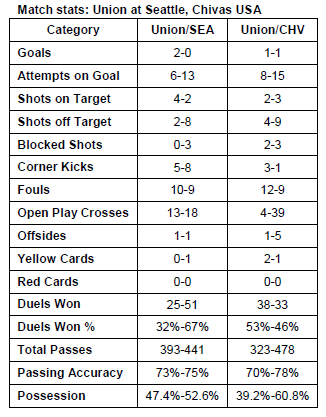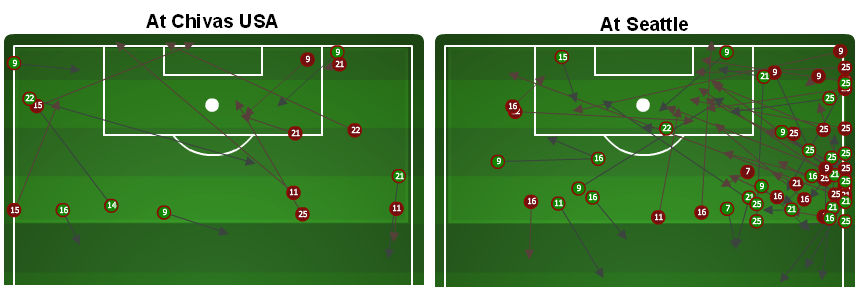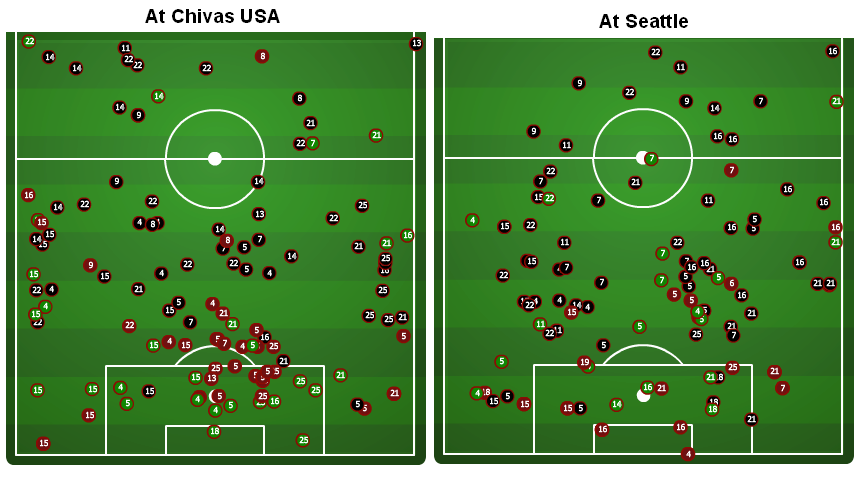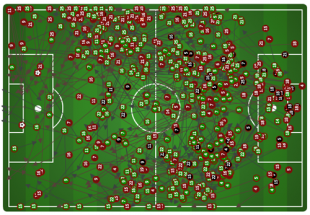The last time the Philadelphia Union played in Seattle it was their debut game as an expansion team, a game that ended as a 2–0 loss. When asked after Saturday night’s 2–0 victory over Seattle what had changed in the 18 months since then, Peter Nowak replied bluntly, “The result changed. That’s more important than anything.”
Of course, a great deal has changed since March 25, 2010.
But what changed in the six days between the 1–1 draw at Chivas USA and the win in Seattle?
Higher shots on goal rate
Compared to their opponents, the Union didn’t have a an advantage in attempts on goal, registering five attempts to Chivas USA’s 15 and six to Seattle’s 13 attempts. But the Union’s shots on goal from attempts on goal percentage was superior to that of both opponents. Chivas managed three shots on goal from 15 attempts for a shots on goal percentage of 20 percent. The Union’s two shots on goal from eight attempts resulted in a shots on goal percentage of 25 percent. Seattle’s shots on goal percentage was 15 percent. Against Seattle, the Union’s shots on goal percentage rose to 67 percent.
 More importantly, Chivas USA’s goals from shots on goal percentage was 33 percent compared to the Union’s 50 percent. Against Seattle, the Union’s conversion rate of shots on goal into goals was again 50 percent. Seattle was shutout. It’s simple, really. Record a higher shots on goal percentage than the other team, and put a higher percentage of those shots on goal into the net, and you’re probably going to win.
More importantly, Chivas USA’s goals from shots on goal percentage was 33 percent compared to the Union’s 50 percent. Against Seattle, the Union’s conversion rate of shots on goal into goals was again 50 percent. Seattle was shutout. It’s simple, really. Record a higher shots on goal percentage than the other team, and put a higher percentage of those shots on goal into the net, and you’re probably going to win.
Better possession and passing
The Union was out-possessed at both Chivas USA and Seattle, but its possession improved over the two road games from 39.2 percent to 47.4 percent. The Union were also more successful with its possession in Seattle. Against Chivas USA six days before, the Union had 323 passes compared to the home team’s 478 and 70 percent of those passes, or 226, were successful. In Seattle, 287 of the Union’s 393 passes, or 73 percent, were successful.
The final third
The Union were more active, and more successfully active, in the final third of the field against Seattle than they were against Chivas USA.  In the first game they had six successful passes and nine unsuccessful passes in the final third of the field. Against Seattle, the Union recorded 28 successful passes and 27 unsuccessful passes. That means the Union’s passing accuracy in the final third improved from 40 percent against Chivas USA to 51 percent against Seattle. More passes + higher passing accuracy = better possession. Better possession = more scoring chances. More scoring chances + more goals.
In the first game they had six successful passes and nine unsuccessful passes in the final third of the field. Against Seattle, the Union recorded 28 successful passes and 27 unsuccessful passes. That means the Union’s passing accuracy in the final third improved from 40 percent against Chivas USA to 51 percent against Seattle. More passes + higher passing accuracy = better possession. Better possession = more scoring chances. More scoring chances + more goals.
Better play on the wings
Much of the improvement in the final third can be attributed to much more active wing play, particularly in combinations between Sheanon Williams and Michael Farfan.
Of the outside backs, against Chivas USA, Sheanon Williams had only seven passes in the final third, of which three were successful. For Gabriel Farfan, it was two passes in the final third against Chivas, one of which was successful. Fast forward to Seattle where Williams had 24 passes in the final third, 12 of which were successful, while Garfan had seven passes, all of which were successful. Not only did both outside backs record more passes, they were more accurate, with Williams improving from 43 percent accuracy to 50 percent and Garfan from 50 percent to 100 percent accuracy.
Williams’ increased production against Seattle is reflected in Michael Farfan’s numbers at right midfield. Marfan had three passes in the final third at Chivas USA, one of which was successful. In Seattle, Marfan had ten passes, seven of which were successful. A Union right wing featuring Marfan and the Sheanomenon on the attack is looking like it could be a very dangerous weapon, indeed.
More active in the midfield
Against Chivas USA the Union seemed to be doing a lot of going over the midfield rather than through the midfield. Of the 323 total passes attempted, 136, or 42 percent came from the midfield. Against Seattle, 209 of the 393 attempted passes came from the midfield, an increase to 53 percent. (I’ve included Paunovic is included in the midfield passing totals.)
Midfield passing accuracy did drop from 82 percent (111 successful passes from 136 passes attempted) to 77 percent (161 successful passes from 209 passes attempted), but the passing accuracy of three key starters in Seattle—Carroll, Marfan and Adu—went up: Carroll from 74 percent against Chivas USA to 80 percent against Seattle; Marfan from 58 percent to 74 percent; Adu from 63 percent to 68 percent.
Breaking up the opponent’s attack
The Union was also more effective defensively in interrupting Seattle’s attack then they were against Chivas USA.
Here is a run down of some key defensive statistical categories against Chivas: tackles won: 9; defender block: 3; interception: 12; clearance: 41; blocked cross: 1; recovery: 42. Against Seattle, the numbers for the same categories are: tackles won: 9; defender block: 3; interception: 17; clearance: 20; blocked cross: 2; recovery: 50.
What sticks out is the increased number of interceptions and recoveries (in black in the image below) compared to the reduced number of clearances (in red). This suggests that, because they were able to cut the number of crosses they had to defend in Seattle nearly in half compared to what they had to defend at Chivas USA, not only were the Union able to disrupt Seattle’s attack more effectively, they were also able to do so more efficiently; the chances of maintaining possession from interceptions and recoveries is greater than from clearances.
 Better distribution from MacMath
Better distribution from MacMath
The scoreline speaks volumes. MacMath faced three shots on goal against Chivas and made two saves. In Seattle he faced two shots on goal and saved both. Additionally, despite a nagging ankle injury, MacMath was more active in commanding his area against Seattle than he was at Chivas USA. In the first game, MacMath recorded three catches, two punches and one clearance. In Seattle it was five catches, four punches and two clearances.
But MacMath was also more efficient in distributing the ball. Against Chivas, he made 31 passes, nine of which were successful, an accuracy rate of 29 percent. In Seattle, MacMath made 25 passes, 18 of which were successful, an accuracy rate of 72 percent. The more accurately MacMath is able to connect with attempts to move the ball out of the Union’s half of the field into the attack, the more chances the Union will have at turning an attack into goals.
Looking at the leading goalkeeping statistics, MacMath’s goals allowed average is 1.07, compared to 1.06 for Faryd Mondragon, a particularly remarkable number when you remember the four goals allowed against New England in his first start. He has three shutouts from seven starts compared to Mondragon’s seven shutouts from 25 starts. At present, MacMath’s win percentage of 38 percent and save percentage of 64 percent are both superior to Mondragon’s 32 percent and 61 percent, respectively.
One final thing
It can’t be measured by any statistic, merely suggested. But did you feel it watching the game, that sense of renewed self-belief, that feeling of confidence? Yes, Seattle were tired after winning the US Open Cup earlier in the week. Yes, they were without key starters and a key defender left the game in the second half. But Seattle’s twelfth man showed up in the person of 35,000-plus screaming supporters. As much as you can sense something by watching the broadcast of an event happening thousands of miles away, didn’t the Union simply feel stronger?
Long may it last.


Pretty shocking on “The Final Third” chart how many 25s and 21s appear compared to only two 22s and two 11s.
Pretty amazing… The U must be trying to protect Mapp – their website lists both him and Marfan as #21
Mapp in final third against Chivas: 1 successful pass (cross, first half), one unsuccessful pass (cross, second half).
Mapp in the final third against Seattle: 1 successful pass (key pass, first half), 1 unsuccessful pass (cross, second half).
Mapp in the middle third against Chivas: 25 successful passes from 28 attempted (14 successful in first half, 11 in second half).
Mapp in middle third against Seattle: 23 successful passes from 28 attempted (19 first half, 4 second half).
Total successful passes against Chivas: 28 from 32 attempted (88% accuracy)
Total successful passes against Seattle: 25 from 31 attempted (81% accuracy).
Ed, as to the different feeling watching the game, I totally agree. I was watching much of the first half on mute, but for the first time in a long time, I just was not worried about Seattle, and felt completely confident the U would get something from the game. Can’t say why, but I was sure, and boy did they prove me right.